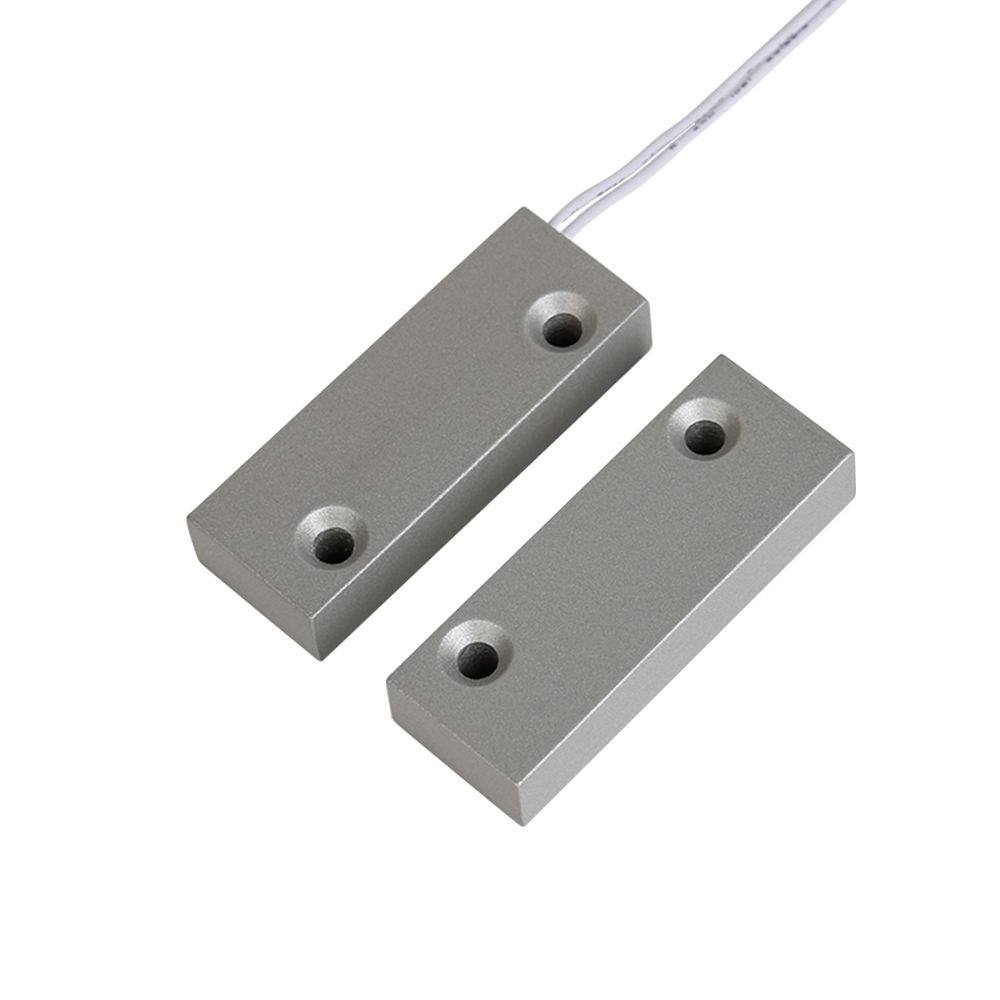What is a Door Contact Sensor?
A door contact sensor is a peripheral security sensor that lets an alarm system know whether a door is opened or closed. When a door is opened, the sensor will activate and let the system know about the situation. The system will then respond based on the programming settings for that zone.

What is a reed switch?
An ordinary switch has two electrical contacts in it that join together when you push a button and spring apart when you release it. Rocker switches on wall lights (like the one in the photo up above) push the two contacts together when the switch is in one position and pull them apart when the switch flicks the other way.
In a typical reed switch, the two contacts (which look like metal reeds) are made from a ferromagnetic material (that means something as easy to magnetize as iron), coated with a hardwearing metal such as rhodium or ruthenium (to give them a long life as they switch on and off), and sealed inside a thin glass envelope filled with an unreactive gas (typically nitrogen) to keep them free of dust and dirt. Sometimes the glass has an outer casing of plastic for even greater protection. Typically, the contacts are made from a nickel-iron alloy that’s easy to magnetize (technically, we say it has a high magnetic permeability) but doesn’t stay that way for long (we say it has a low magnetic retentivity). They take some time to respond to changes in the magnetic field (we say they have quite a bit of hysteresis)—in other words, they move quite slowly and smoothly. Generally both contacts move (not just one) and they make a flat, parallel area of contact with one another (rather than simply touching at a point), because that helps to extend the life and reliability of the switch.
Although most reed switches have two ferromagnetic contacts, some have one contact that’s ferromagnetic and one that’s non-magnetic, while some (like the original Elwood reed switch illustrated at the bottom of this article) have three.

How does a reed switch work?
Reed switches come in two main varieties called normally open (normally switched off) and normally closed (normally switched on). The key to understanding how they work is to realize that they don’t just work as an electrical bridge but as a magnetic one as well: magnetism flows through them as well as electricity.
Normally open
As you bring a magnet up to the reed switch, the entire switch effectively becomes a part of a “magnetic circuit” that includes the magnet (the dotted line in the artwork shows part of the magnetic field). The two contacts of the reed switch become opposite magnetic poles, which is why they attract and snap together. It doesn’t matter which end of the magnet approaches first: the contacts still polarize in opposite ways and attract one another. A reed switch like this is normally open (NO) (normally off), unless a magnet is positioned right next to it, when it switches on, allowing a current to flow through it.
Take the magnet away and the contacts—made from fairly stiff and springy metal—push apart again and return back to their original positions.
Normally closed
You can also get reed switches that work the opposite way: the two contacts are normally snapped together and when you bring a magnet up to the switch, spring apart. Reed switches like this are called normally closed (NC) (normally switched on), so electricity flows through them most of the time. The easiest way of making one is to take a normally open switch and fix a magnet permanently to its glass case, flipping it over from its open to its closed state (as in the second frame in the normally open animation up above). This entire unit (normally open reed switch with magnet attached) becomes our normally closed reed switch. If you bring a second magnet up to it, with a magnetic field of opposite polarity to that of the first magnet, this new field cancels out the field of the first magnet so we have, in effect, exactly what we had in the first frame of the normally open animation: a reed switch with two contacts sprung apart.
In these two artworks, I’ve massively exaggerated the movement of the contacts. Real reed switches have contacts that are only a few microns (millionths of a meter) apart—roughly ten times thinner than a human hair—so the movement isn’t visible to the naked eye. Don’t expect to see the blades moving as you bring your magnet up close!
Another crucial thing I need to point out is that reed switches don’t simply switch on when a magnet moves up close and off when it moves away (in the case of a normally open/off switch): they will typically switch on and off several times as the magnet moves by, creating multiple on and off zones. They’ll also respond differently according to the orientation of the magnet (whether it’s parallel to the switch or perpendicular), what shape it is (because, as we all learned in school, different shaped magnets create different magnetic field patterns all around them), and how it moves past. This is really important when it comes to practical applications: you need to make sure you use the right magnet and that it moves in just the right way to actuate your reed switch. If you’re using a reed switch as a counter, for example, it should actuate only once each time the magnet moves by (not three or four times, which would give a false reading). If you’re using a reed switch in an alarm, you don’t want your intruder switching the alarm on one second and then off again a second later because you put the magnet in the wrong place!

